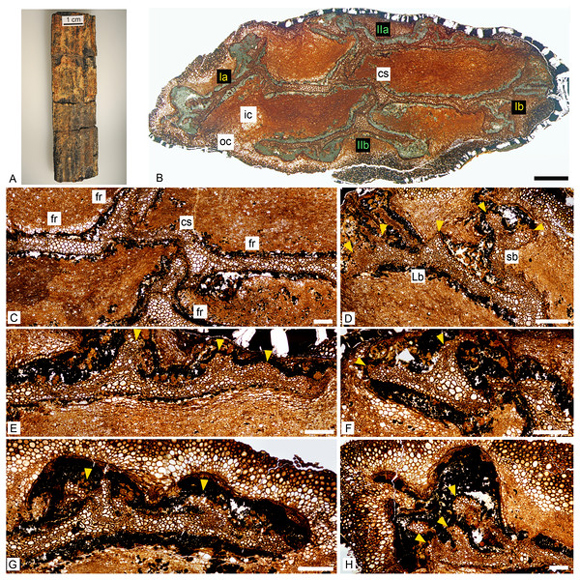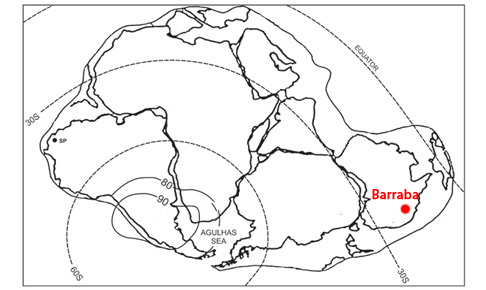Keraphyton mawsoniae – Late Devonian Fern-like Plant
A fossil found more than fifty years ago and described as a “fossilised stick” has proved to be a new species of Late Devonian plant and it is helping scientists to better understand the flora of the landmass of Gondwana. The specimen measures a little over 9 cm in length, with a width across its ribbed surface of around 2 cm.
It was found by amateur geologist John Irving whilst exploring the banks of the Manilla River in Barraba (New South Wales, Australia), after a period of extensive flooding. It remained unstudied in the fossil collection of the geological survey of New South Wales for five decades until it was despatched to France as part of a wider study to map plant evolution.
Keraphyton mawsoniae
The Fossil and Cross-sectional Slices (K. mawsoniae)

Picture credit: Champreux et al (PeerJ)
The picture (above), shows (A) the fossil specimen before preparation, (B) a general view of the stem system shown in cross-section, with (C-H) highly magnified areas showing the internal structure of the plant. The fossil is from the Mandowa Mudstone Formation (Upper Devonian) and it is believed to represent a plant stem.
A Very Rare Fossil Discovery
During the Middle to Late Devonian land plants were becoming larger, more complex and diverse. Major groups of plants that were to dominate the flora of the Mesozoic evolved and the first widespread forests and land-based ecosystems became established. Well-preserved plant fossils from this time in Earth’s history are exceptionally rare. Plants related to ferns and other types that produce seeds (Euphyllophytina), became more specious during this time in Earth’s history, fossils of fern-like plants are known from the northern hemisphere but the Gondwanan record is extremely sparse.
The French laboratory of Botany and Modelling of Plant Architecture and Vegetation (AMAP) in Montpellier has been collating data on early plant species from the Devonian/Carboniferous of Australia and Antoine Champreux, studied the fossil specimen as part of his Master’s Degree before completing his research whilst a PhD student at Flinders University in South Australia.
Gondwana During the Late Devonian (Position of Australia)

Picture credit: University of Witwatersrand with additional annotation from Everything Dinosaur
A “Fossilised Stick”
Antoine commented:
“It’s nothing much to look at – just a fossilised stick – but it’s far more interesting once we cut it and had a look inside. The anatomy is preserved, meaning that we can still observe the walls of million-year-old cells. We compared the plant with other plants from the same period based on its anatomy only, which provide a lot of information.”
The research team found that this early land plant represents a new genus of plant, sharing some similarities with modern ferns and horsetails.
Antoine added:
“It is an extraordinary discovery, since such exquisitely-preserved fossils from this period are extremely rare. We named the genus Keraphyton (like the horn plant in Greek), and the species Keraphyton mawsoniae, in honour of our partner Professor Ruth Mawson, a distinguished Australian palaeontologist who died in 2019.”
To read about a bizarre, giant predatory marine worm from the Devonian: Monster Worm of the Devonian.
The scientific paper: “Keraphyton gen. nov., a new Late Devonian fern-like plant from Australia” by Antoine Champreux, Brigitte Meyer-Berthaud, and Anne-Laure Decombeix published in the open access journal PeerJ.
The Everything Dinosaur website: Visit Everything Dinosaur.






Leave A Comment